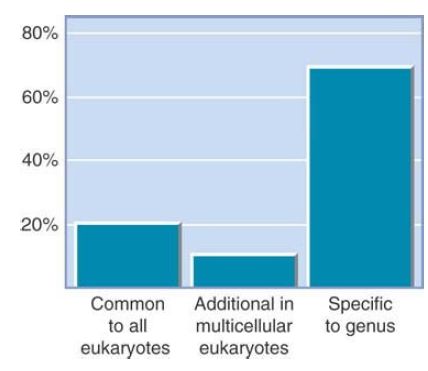
How Many Different Types of Genes Are There
 المؤلف:
JOCELYN E. KREBS, ELLIOTT S. GOLDSTEIN and STEPHEN T. KILPATRICK
المؤلف:
JOCELYN E. KREBS, ELLIOTT S. GOLDSTEIN and STEPHEN T. KILPATRICK
 المصدر:
LEWIN’S GENES XII
المصدر:
LEWIN’S GENES XII
 الجزء والصفحة:
الجزء والصفحة:
 14-3-2021
14-3-2021
 2546
2546
How Many Different Types of Genes Are There?
KEY CONCEPTS
-The sum of the number of unique genes and the number of gene families is an estimate of the number of types of genes.
-The minimum size of the proteome can be estimated from the number of types of genes.
Some genes are unique; others belong to families in which the other members are related (but not usually identical). The proportion of unique genes declines, and the proportion of genes in families increases, with increasing genome size. Some genes are present in more than one copy or are related to one another, so the number of different types of genes is less than the total number of genes. We can divide the total number of genes into sets that have related members, as defined by comparing their exons. (A gene family arises by repeated duplication of an ancestral gene followed by accumulation of changes in sequence among the copies. Most often the members of a family are similar but not identical.) The number of types of genes is calculated by adding the number of unique genes (for which there is no other related gene at all) to the numbers of families that have two or more members.
FIGURE 1. compares the total number of genes with the number of distinct families in each of six genomes. In bacteria, most genes are unique, so the number of distinct families is close to the total gene number. The situation is different even in the unicellular eukaryote S. cerevisiae, for which there is a significant proportion of repeated genes. The most striking effect is that the number of genes increases quite sharply in the multicellular eukaryotes, but the number of gene families does not change much.

FIGURE 1. Many genes are duplicated, and as a result the number of different gene families is much smaller than the total number of genes. This histogram compares the total number of genes with the number of distinct gene families.
TABLE 2. shows that the proportion of unique genes drops sharply with increasing genome size. When there are gene families, the number of members in a family is small in bacteria and unicellular eukaryotes, but is large in multicellular eukaryotes. Much of the extra genome size of Arabidopsis is due to families with more than four members.
TABLE 2 The proportion of genes that are present in multiple copies increases with genome size in multicellular eukaryotes.

If every gene is expressed, the total number of genes will account for the total number of polypeptides required by the organism (the proteome). However, there are two factors that can cause the proteome to be different from the total gene number. First, genes can be duplicated, and, as a result, some of them encode the same polypeptide (although it might be expressed at a different time or in a different type of cell) and others might encode related polypeptides that also play the same role at different times or in different cell types. Second, the proteome can be larger than the number of genes because some genes can produce more than one polypeptide by alternative splicing or other means.
What is the core proteome—the basic number of the different types of polypeptides in the organism? Although difficult to estimate because of the possibility of alternative splicing, a minimum estimate is provided by the number of gene families, ranging from 1,400 in bacteria, to about 4,000 in yeast, to 11,000 for the fly, to 14,000 for the worm.
What is the distribution of the proteome by type of protein? The 6,000 proteins of the yeast proteome include 5,000 soluble proteins and 1,000 transmembrane proteins. About half of the proteins are cytoplasmic, a quarter are in the nucleus, and the remainder are split between the mitochondrion and the endoplasmic reticulum (ER)/Golgi system.
How many genes are common to all organisms (or to groups such as bacteria or multicellular eukaryotes), and how many are specific to lower-level taxonomic groups? FIGURE 2 shows the comparison of fly genes to those of the worm (another multicellular eukaryote) and yeast (a unicellular eukaryote). Genes that encode corresponding polypeptides in different species are called orthologous genes, or orthologs .
Operationally, we usually consider that two genes in different organisms are orthologs if their sequences are similar over more than 80% of the length. By this criterion, about 20% of the fly genes have orthologs in both yeast and the worm.
These genes are probably required by all eukaryotes. The proportion increases to 30% when the fly and worm are compared, probably representing the addition of gene functions that are
common to multicellular eukaryotes. This still leaves a major proportion of genes as encoding proteins that are required specifically by either flies or worms, respectively.

FIGURE 2. The fruit fly genome can be divided into genes that are (probably) present in all eukaryotes, additional genes that are (probably) present in all multicellular eukaryotes, and genes that are more specific to subgroups of species that include flies.
A minimum estimate of the size of an organismal proteome can be deduced from the number and structures of genes, and a cellular or organismal proteome size can also be directly measured by analyzing the total polypeptide content of a cell or organism. Using such approaches, researchers have identified some proteins that were not suspected on the basis of genome analysis; this has led to the identification of new genes. Researchers use several methods for large-scale analysis of proteins. They can use mass spectrometry for separating and identifying proteins in a mixture obtained directly from cells or tissues. Hybrid proteins bearing tags can be obtained by expression of cDNAs made by ligating the sequences of ORFs to appropriate expression vectors that incorporate the sequences for affinity tags. This allows array analysis to be used to analyze the products. These methods also can be effective in comparing the proteins of two tissues—for example, a tissue from a healthy individual and one from a patient with a disease—to pinpoint the differences.
After we know the total number of proteins, we can ask how they interact. By definition, proteins in structural multiprotein assemblies must form stable interactions with one another. Also, proteins in signaling pathways interact with one another transiently. In both cases, such interactions can be detected in test systems where essentially a readout system magnifies the effect of the interaction.
Such assays cannot detect all interactions; for example, if one enzyme in a metabolic pathway releases a soluble metabolite that then interacts with the next enzyme, the proteins might not interact directly.
As a practical matter, assays of pairwise interactions can give us an indication of the minimum number of independent structures or pathways. An analysis of the ability of all 6,000 predicted yeast proteins to interact in pair-wise combinations shows that about 1,000 proteins can bind to at least one other protein. Direct analyses of complex formation have identified 1,440 different
proteins in 232 multiprotein complexes. This is the beginning of an analysis that will lead to defining the number of functional assemblies or pathways. A comparable analysis of 8,100 human proteins identified 2,800 interactions, but this is more difficult to interpret in the context of the larger proteome.
In addition to functional genes, there are also copies of genes that have become nonfunctional (identified as such by mutations in their protein-coding sequences). These are called pseudogenes. The number of pseudogenes can be large. In the mouse and human genomes, the number of pseudogenes is about 10% of the number of (potentially) functional genes . Some of these pseudogenes may serve the function of acting as targets for regulatory microRNAs;.
 الاكثر قراءة في مواضيع عامة في الاحياء الجزيئي
الاكثر قراءة في مواضيع عامة في الاحياء الجزيئي
 اخر الاخبار
اخر الاخبار
اخبار العتبة العباسية المقدسة


